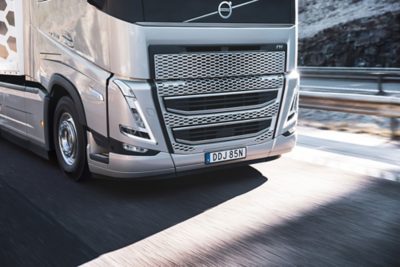Aerodynamic resistance has a major impact on the fuel efficiency of your truck, especially when it’s travelling at speeds exceeding 50 km/h. The key to reducing this impact and lowering your fuel costs is understanding how truck aerodynamics work.
How does aerodynamics affect fuel efficiency?
When a truck pushes through the air, it is met with significant aerodynamic resistance – the force exerted by air. While air resistance occurs at any vehicle speed, its relationship to speed is not proportional. So, when speed doubles, air resistance increases by four times. If speed triples, the resistance increases by nine times, and so on.
This has a dramatic effect on the energy efficiency of a heavy duty truck, especially when it is travelling at high speeds on a motorway. In fact, air resistance can account for as much as a third of fuel losses on a typical long-haul diesel operation. For battery electric trucks, the energy losses can be as much as 50 percent. A truck’s aerodynamics therefore has one of the biggest direct influences on fuel efficiency and, in turn, environmental impact.
Understanding truck air flow and how to reduce aerodynamic drag
In order to lower the impact of air resistance, it’s important to delay or minimise air flow separation. This is when a layer of air flow detaches from the truck’s surface and becomes highly turbulent. The earlier it detaches, the larger the wake behind the truck and therefore the higher the pressure drag.
One way of reducing air flow separation is to seal the gaps on the front of the truck where possible. The front corners in particular are a sensitive area where even small gaps can cause the air to detach, creating a significant impact on the overall air flow.
“When air flow approaches a truck corner, think of it like a carousel fairground ride. You need to hold on to stay on the curved path. It’s the same with air flow, except it does not have hands to cling on to a surface like we do. To stay attached, air has to use low pressure,” says Anders Tenstam, Technology Specialist Aerodynamics, Volvo Trucks.
Filling in gaps on the front of the truck also opens up other areas for improvement, such as longer door extensions to reduce the void in the footstep box. This delays flow separation as the air has a flat surface to attach to.
The same principle applies to fender flares that decrease the gap above the wheel. Truck mirrors can also be improved with curved lines and smaller peak holes, and mirror cams, instead of actual mirrors, will reduce the frontal area of the truck resulting in less aerodynamic drag.

As we look to the future, it is essential that trucks are as energy efficient as possible and advances in aerodynamics will have a major role to play
The importance of specifying your truck with cab roof and side deflectors
The roof deflector is the most important aerodynamic device for reducing fuel consumption. It does depend on the type of operation, but many truck businesses will benefit from a roof deflector, provided it is selected and fitted to suit the trailer configuration. Ensuring the optimum height is crucial - recent findings based on simulations at Volvo Trucks indicate that it can save between two to six percent* in fuel if it is set correctly.
The type of trailer used in your daily operations will also have an impact on how your aerodynamic fittings work and how much fuel or energy you can save. For example, when combined, simulations show that the cab roof deflector and cab side deflectors can lower fuel consumption by as much as four to five percent* on a typical long-haul operation.
For operations with different types of trailer configurations, the amount of fuel you can save will vary, but the cab roof and side deflectors will still have a positive impact. This is because when the air flow is released from the back of the cab, it is sucked into the gap between the cab and the cargo, creating significant air resistance. To shelter a non-aerodynamic load from this air pattern, correctly positioned roof and side deflectors are essential.
The future of truck aerodynamics
Advances in virtual simulation have opened up new possibilities for visualising and analysing truck air flow behaviour and aerodynamics. Simulation parameters can easily be adjusted and run again and again in a short space of time. This has speeded up the verification process and lead times for aerodynamic improvements to come to market.
“It is a fast-paced and ever-growing field. You can now go into whatever detail you want on the truck to gain knowledge about air flow, and enhance aerodynamic performance,” says Mattias Hejdesten, Engineering Specialist Aerodynamics, Volvo Trucks.
The recent update to the EU weight and dimension legislation for trucks, removing the total length restriction of 16.5 metres, has also enabled more freedom when it comes to aerodynamic shape optimisation on the truck’s exterior.
“All this has changed the way truck manufacturers are working with aerodynamics, and truck businesses can expect to see more design changes in the future,” says Mattias Hejdesten.
Furthermore, aerodynamics is no longer just about reducing fuel consumption. It is about increasing energy efficiency, regardless of the type of fuel the truck is running on, to lower environmental impact.
Enhanced aerodynamics is especially important for battery electric trucks, which have less energy available. Making the right choices about fittings, and considering the aerodynamic design when specifying your truck with your supplier, is therefore one of the most important ways to optimise routes and increase range.
“As we look to the future, it is essential that trucks are as energy efficient as possible and advances in aerodynamics will have a major role to play,” says Anders Tenstam.

When air flow approaches a truck corner, think of it like a carousel fairground ride. You need to hold on to stay on the curved path. It’s the same with air flow, except it does not have hands to cling on to a surface like we do

When air flow approaches a truck corner, think of it like a carousel fairground ride. You need to hold on to stay on the curved path. It’s the same with air flow, except it does not have hands to cling on to a surface like we do
6 ways to improve fuel economy by optimising truck aerodynamics
- Ensure the roof deflector is at the correct height for your trailer configuration.
- Consider adding cab side deflectors to reduce aerodynamic drag.
- Where possible, adjust the roof deflector to suit the load you are carrying.
- As aerodynamic resistance increases with speed, consider reducing the average speed of your trucks if possible.
- Consider other aerodynamic fittings that can help to lower fuel consumption, such as bumper spoilers, chassis skirts and fender flares.
- Avoid truck accessories, such as bull bars, air horns and extra lights as these will increase aerodynamic resistance.
*Based on a typical long-haul diesel operation and standard trailer configuration, and extensive virtual simulations and research conducted by Volvo Trucks. Actual fuel economy may vary depending on many factors i.e. driving speed, use of cruise control, vehicle specification, vehicle load, actual topography, the driver´s driving experience, vehicle maintenance, and weather conditions.